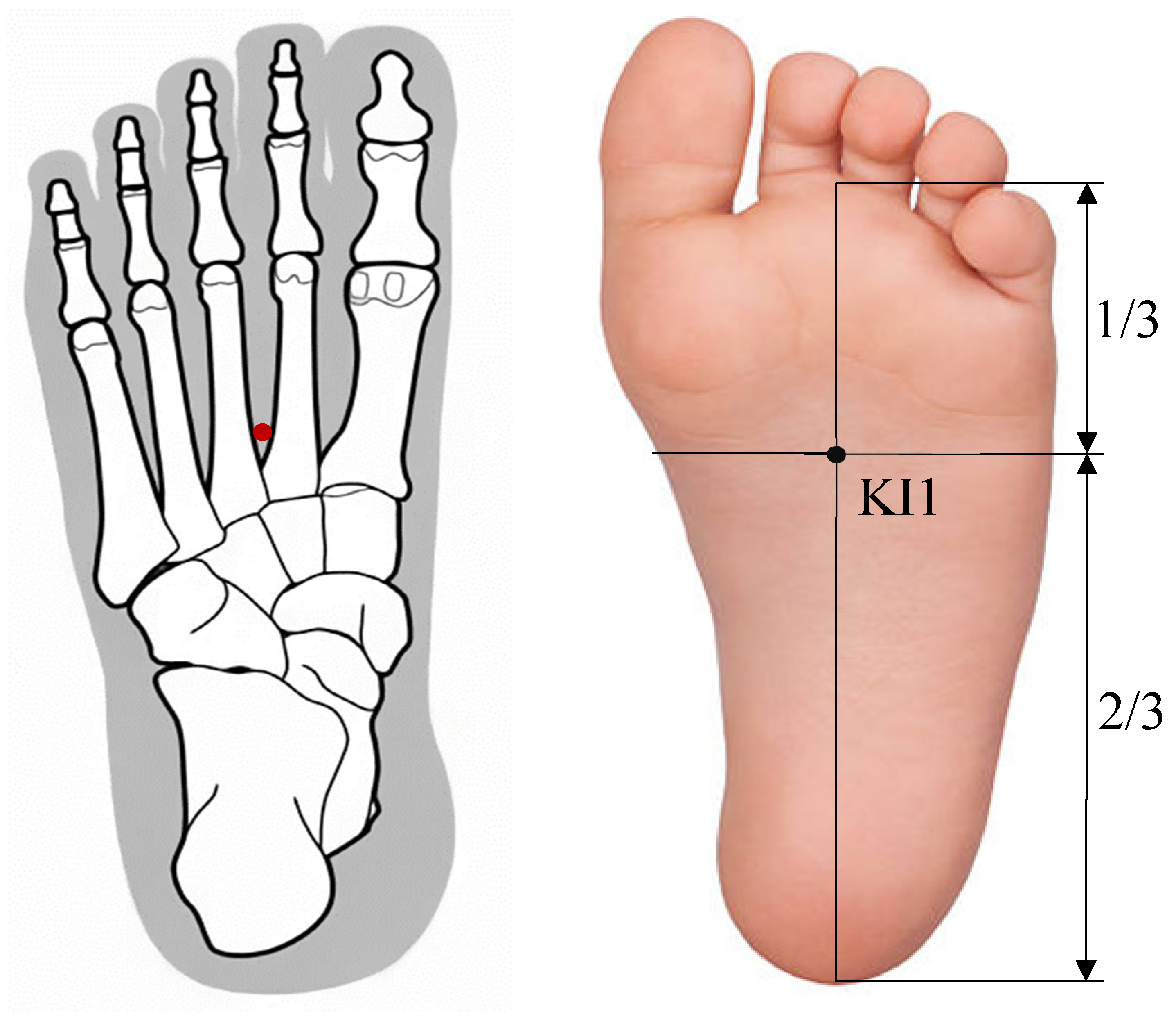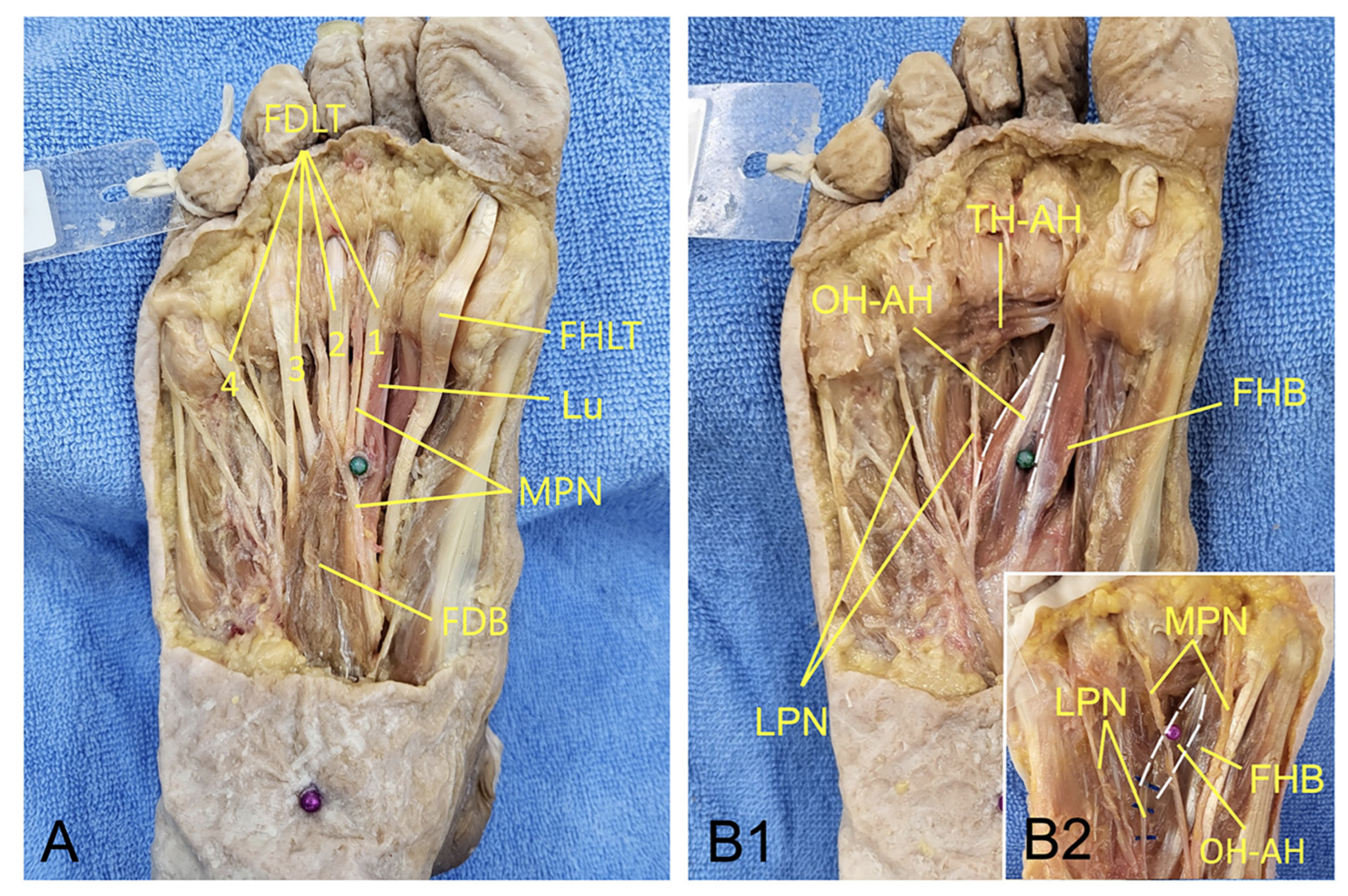Anatomical Exploration of the KI1 Acupoint: Implications for Medial and Lateral Plantar Nerve Stimulation
Abstract
1. Introduction
2. Materials and Methods
3. Results
4. Discussion
5. Conclusions
Author Contributions
Funding
Institutional Review Board Statement
Informed Consent Statement
Data Availability Statement
Acknowledgments
Conflicts of Interest
References
- Lim, T.-K.; Ma, Y.; Berger, F.; Litscher, G. Acupuncture and Neural Mechanism in the Management of Low Back Pain—An Update. Medicines 2018, 5, 63. [Google Scholar] [CrossRef] [PubMed]
- Maurer, N.; Nissel, H.; Egerbacher, M.; Gornik, E.; Schuller, P.; Traxler, H. Anatomical Evidence of Acupuncture Meridians in the Human Extracellular Matrix: Results from a Macroscopic and Microscopic Interdisciplinary Multicentre Study on Human Corpses. Evid. Based Complement. Altern. Med. 2019, 2019, 6976892. [Google Scholar] [CrossRef] [PubMed]
- Kato, Y.; Yachi, K.; Hoshi, H.; Okada, T.; Shigihara, Y. Two Distinct Neural Mechanisms Underlying Acupuncture Analgesia. Front. Pain Res. 2022, 3, 869884. [Google Scholar] [CrossRef] [PubMed]
- Plaut, S. Suggesting a Mechanism for Acupuncture as a Global Percutaneous Needle Fasciotomy That Respects Tensegrity Principles for Treating Fibromyalgia. Front. Med. 2023, 9, 952159. [Google Scholar] [CrossRef]
- Dorsher, P.T.; Fleckenstein, J. Trigger Points and Classical Acupuncture Points: Part 1: Qualitative and Quantitative Anatomic Correspondences *. Dtsch. Z. Für Akupunkt. 2008, 51, 15–24. [Google Scholar] [CrossRef]
- Liu, S.; Wang, Z.; Su, Y.; Qi, L.; Yang, W.; Fu, M.; Jing, X.; Wang, Y.; Ma, Q. A Neuroanatomical Basis for Electroacupuncture to Drive the Vagal–Adrenal Axis. Nature 2021, 598, 641–645. [Google Scholar] [CrossRef] [PubMed]
- Kim, S.A.; Lee, B.H.; Bae, J.H.; Kim, K.J.; Steffensen, S.C.; Ryu, Y.-H.; Leem, J.W.; Yang, C.H.; Kim, H.Y. Peripheral Afferent Mechanisms Underlying Acupuncture Inhibition of Cocaine Behavioral Effects in Rats. PLoS ONE 2013, 8, e81018. [Google Scholar] [CrossRef] [PubMed]
- Kong, X.-Y.; Xiang, M.; Fang, J.; Han, D.; Song, B.; Jiang, L. The Connection between Meridians and Physiological Functions: A Quantum Principle. Nano Res. 2023, 16, 12817–12820. [Google Scholar] [CrossRef]
- Lou, X.-F.; Jiang, S.-H. Anatomical characters and classification of acupoint. Zhongguo Zhen Jiu 2012, 32, 319–323. [Google Scholar]
- Fan, Y.; Ryu, Y.; Zhao, R.; Bills, K.B.; Steffensen, S.C.; Yang, C.H.; Kim, H.Y. Enhanced Spinal Neuronal Responses as a Mechanism for Increased Number and Size of Active Acupoints in Visceral Hyperalgesia. Sci. Rep. 2020, 10, 10312. [Google Scholar] [CrossRef]
- Zhang, H.; Sun, X.; Liu, S.; Chen, Y.; Ling, F. Neuronal Activation by Acupuncture at Yongquan (KI1) and Sham Acupoints in Patients with Disorder of Consciousness: A Positron Emission Tomography Study. Neural Regen. Res. 2014, 9, 500–501. [Google Scholar] [CrossRef] [PubMed]
- Lin, C.-H.; Lin, Y.-H.; Tzeng, I.-S.; Kuo, C.-Y. An Association Rule Analysis of the Acupressure Effect on Sleep Quality. Evid. Based Complement. Altern. Med. 2021, 2021, 1399258. [Google Scholar] [CrossRef] [PubMed]
- Zhang, N.; Shen, Y.; Zhu, W.; Li, C.; Liu, S.; Li, H.; Wang, Y.; Wang, J.; Zhang, Q.; Sun, J.; et al. Spatial Transcriptomics Shows Moxibustion Promotes Hippocampus Astrocyte and Neuron Interaction. Life Sci. 2022, 310, 121052. [Google Scholar] [CrossRef] [PubMed]
- Tang, W.-C.; Hsu, Y.-C.; Wang, C.-C.; Hu, C.-Y.; Chio, C.-C.; Kuo, J.-R. Early Electroacupuncture Treatment Ameliorates Neuroinflammation in Rats with Traumatic Brain Injury. BMC Complement. Altern. Med. 2016, 16, 470. [Google Scholar] [CrossRef]
- Yang, L.; Yang, L.; Gao, X. Transcutaneous Electrical Nerve Stimulation on Yongquan Acupoint Reduces CFA-Induced Thermal Hyperalgesia of Rats via down-Regulation of ERK2 Phosphorylation and c-Fos Expression. Anat. Rec. 2010, 293, 1207–1213. [Google Scholar] [CrossRef] [PubMed]
- Korean Medicine Convergence Research Information Center. Governor Vessel. KMCRIC Website. Available online: www.kmcric.com/database/acupoint/KI/KI1 (accessed on 19 February 2024).
- Moore, K.L.; Dalley, A.F.; Agur, A.M. Moore Clinically Oriented Anatomy, 8th ed.; Wolters Kluwer Health Inc: Philadelphia, PA, USA, 2020. [Google Scholar]
- Lee, M.; Longenecker, R.; Lo, S.; Chiang, P. Distinct Neuroanatomical Structures of Acupoints Kidney 1 to Kidney 8: A Cadaveric Study. Med. Acupunct. 2019, 31, 19–28. [Google Scholar] [CrossRef] [PubMed]
- Luo, G.; Houston, V.L.; Mussman, M.; Garbarini, M.; Beattie, A.C.; Thongpop, C. Comparison of Male and Female Foot Shape. J. Am. Podiatr. Med. Assoc. 2009, 99, 383–390. [Google Scholar] [CrossRef] [PubMed]
- Heß, T.; Themann, P.; Oehlwein, C.; Milani, T.L. Does Impaired Plantar Cutaneous Vibration Perception Contribute to Axial Motor Symptoms in Parkinson’s Disease? Effects of Medication and Subthalamic Nucleus Deep Brain Stimulation. Brain Sci. 2023, 13, 1681. [Google Scholar] [CrossRef]
- Wegrzyk, J.; Ranjeva, J.-P.; Fouré, A.; Kavounoudias, A.; Vilmen, C.; Mattei, J.-P.; Guye, M.; Maffiuletti, N.A.; Place, N.; Bendahan, D.; et al. Specific Brain Activation Patterns Associated with Two Neuromuscular Electrical Stimulation Protocols. Sci. Rep. 2017, 7, 2742. [Google Scholar] [CrossRef]
- Zhang, Z.-J.; Wang, X.-M.; McAlonan, G.M. Neural Acupuncture Unit: A New Concept for Interpreting Effects and Mechanisms of Acupuncture. Evid. Based Complement. Altern. Med. 2012, 2012, 429412. [Google Scholar] [CrossRef]
- Zheng, Y.; Wang, Y.; Yue, Z.; Wang, X.; Zhang, J.; Fang, J. Transcranial Direct Current Stimulation Modulates the Brain’s Response to Foot Stimuli under Dual-Task Condition: A fMRI Study in Elderly Adults. Neurosci. Lett. 2019, 692, 225–230. [Google Scholar] [CrossRef]
- Pagnussat, A.S.; Salazar, A.P.; Pinto, C.; Redivo Marchese, R.; Rieder, C.R.M.; Alves Filho, J.O.; Franco, A.R.; Kleiner, A.F.R. Plantar Stimulation Alters Brain Connectivity in Idiopathic Parkinson’s Disease. Acta Neurol. Scand. 2020, 142, 229–238. [Google Scholar] [CrossRef] [PubMed]
- Cui, X.; Liu, K.; Gao, X.; Zhu, B. Advancing the Understanding of Acupoint Sensitization and Plasticity Through Cutaneous C-Nociceptors. Front. Neurosci. 2022, 16, 822436. [Google Scholar] [CrossRef] [PubMed]
- Xiao, L.-Y.; Wang, X.-R.; Ye, Y.; Yang, J.-W.; Cao, Y.; Ma, S.-M.; Li, T.-R.; Liu, C.-Z. Applications of Acupuncture Therapy in Modulating Plasticity of Central Nervous System. Neuromodulation Technol. Neural Interface 2018, 21, 762–776. [Google Scholar] [CrossRef] [PubMed]
- Ma, S.; Huang, H.; Zhong, Z.; Zheng, H.; Li, M.; Yao, L.; Yu, B.; Wang, H. Effect of Acupuncture on Brain Regions Modulation of Mild Cognitive Impairment: A Meta-Analysis of Functional Magnetic Resonance Imaging Studies. Front. Aging Neurosci. 2022, 14, 914049. [Google Scholar] [CrossRef] [PubMed]
- Li, A.; Wang, Y.; Zhang, F.; Wang, F.; Zeng, X.; Yue, J.; Li, X.; Zhang, Q. Acupuncture for Gender Differences and Similarities in Cerebral Activity of Health Volunteers. Medicine 2018, 97, e13655. [Google Scholar] [CrossRef] [PubMed]
- Ansuategui Echeita, J.; Hijmans, J.M.; Smits, S.; Van der Woude, L.H.; Postema, K. Age-related differences in women’s foot shape. Maturitas 2016, 94, 64–69. [Google Scholar] [CrossRef]
- Nayak, S.B.; Vasudeva, S.K. Accessory Slip of Flexor Digitorum Accessorius (Quadratus Plantae) Muscle Surrounding the Lateral Plantar Nerve and Vessels. Morphologie 2022, 106, 214–216. [Google Scholar] [CrossRef]


Disclaimer/Publisher’s Note: The statements, opinions and data contained in all publications are solely those of the individual author(s) and contributor(s) and not of MDPI and/or the editor(s). MDPI and/or the editor(s) disclaim responsibility for any injury to people or property resulting from any ideas, methods, instructions or products referred to in the content. |
© 2024 by the authors. Licensee MDPI, Basel, Switzerland. This article is an open access article distributed under the terms and conditions of the Creative Commons Attribution (CC BY) license (https://creativecommons.org/licenses/by/4.0/).
Share and Cite
Kim, S.H.; Joung, J.-Y.; Lee, Y.H.; Son, C.-G. Anatomical Exploration of the KI1 Acupoint: Implications for Medial and Lateral Plantar Nerve Stimulation. Medicina 2024, 60, 535. https://doi.org/10.3390/medicina60040535
Kim SH, Joung J-Y, Lee YH, Son C-G. Anatomical Exploration of the KI1 Acupoint: Implications for Medial and Lateral Plantar Nerve Stimulation. Medicina. 2024; 60(4):535. https://doi.org/10.3390/medicina60040535
Chicago/Turabian StyleKim, Sang Hyun, Jin-Yong Joung, Young Ho Lee, and Chang-Gue Son. 2024. "Anatomical Exploration of the KI1 Acupoint: Implications for Medial and Lateral Plantar Nerve Stimulation" Medicina 60, no. 4: 535. https://doi.org/10.3390/medicina60040535
APA StyleKim, S. H., Joung, J.-Y., Lee, Y. H., & Son, C.-G. (2024). Anatomical Exploration of the KI1 Acupoint: Implications for Medial and Lateral Plantar Nerve Stimulation. Medicina, 60(4), 535. https://doi.org/10.3390/medicina60040535







